Share
Pin
Tweet
Send
Share
Send
Daria Privalikhina - a young designer, semi-finalist of the Moscow Fashion Start 2015 Design Competition, told us about her collection and shared the secrets of creating designer clothes.

The collection includes dresses, jackets, coats, overalls. The models are based on a straight silhouette, but the main feature of these products lies in the reliefs. Somewhere they emphasize the figure, and somewhere they tell about some story of a woman.

The interweaving of forms, intricacies - this is the main idea of the collection. Reliefs breathe new life into a dress and make you see its owner in a new way. The designer uses an unusual combination of fabrics; faux leather and linen, mixed fabric and suede, coat.

The color scheme is restrained, black color prevails, but there is also dark green, gold, burgundy, scarlet.
How is a model created?

Daria Privalikhina decided to tell how a designer model is created using the example of a basic classic black dress.
Construction
Description of the model: women's dress, sleeveless. Made of faux leather. The silhouette is straight. On the shelf are reliefs creating a geometric ornament. Zipper in the middle seam of the back. Recommended size 42−44.| Name of material | Consumption rate | price, rub. | Cost, rub. |
| Faux leather, width 1.5 m | 1,5 m | 380 | 570 |
| Lining fabric shir 1,5 m | 1,5 m | 225 | 337,5 |
| Lightning | 1 PC. | 570 | 570 |
| Thread | 1 cat. | 60 | 60 |
| The amount of costs for materials: | 1537,5 |
Calculation and construction of sections of the design drawing of a female dress
The absolute values of a particular female figure of size 176−84−90, adopted during the development of the design of the model of the female dress.
Calculation of the construction of sections of the drawing of a women's dress
Calculation of product width by sections
A0a = Shs + Pshs: 16,5 + 1,0 = 17,5aa2 = dpr + pshpr - armhole: 7.8 + 2.8 = 10.6
A0a1 = Cr3 + Pg: 42,0 + 5,0 = 47,0
a1a2 = Cg + (Cg2 - Cg1) + nsc - shelf: 20.6
Calculation of product sections vertically from point A0
A0G = Vprz + Pspr + 0.5 PDTS - armhole depth level: 21.3 + 2.0+ 0.5 = 23.8A0T = Dts2 + PDTS - waist level: 44.0 + 1.0 = 45.5
TB = 0.5Dts2 - 2, 0 - hips: 0.5 * 44.0 - 2.0 = 20.0
Build the back of the dress
Neck construction
А0А2 = Сш: 3 + Пшг - neck width: 15.5: 3 + 2.0 = 7.1A0A = A0A2: 3 - neck depth: 7.1: 3 = 2.4
AN = Dee: 96,0
TT1: 0
Drawing shoulder lines and armholes
A2P1 = Shp - determination of the end point of the shoulder line: 12.0TP1 = VpkII + Pvpk - determination of the end point of the shoulder line: 43.6 + 1.0 + 1.0 = 45.5
G1G2 = 0.5 G1G4 - middle of the armhole: 11.0 * 0.5 = 5.5
G1P3 = P2G1: 3.0 + 2.0 - the point of contact of the armhole with the vertical from point a: 21.0: 3 + 2.0 = 9.0
G11 = 0.2 Shpr + 0.5 - bisector: 0.2 * 13.4 + 0.5 = 3.3
Build the front of the dress
The construction of the neck of the shelf
T3A3 = DTP + PDTP: 44,4 + 2,0 = 46,4A3A4 = A0A2 - neck width: 7.3
A3A5 + A3A4 + 1 - neck depth: 7.3+ 1.0 = 8.3
Shoulder and armholes
A4A9 = (Cr2 - Cr1) * 2 - 1: (44,4 - 42)*2 - 1 = 4,0A9P5 - shoulder width: 12.0
G4P4 = G1P2 (from the drawing of the back) - 0.5: 21,0 - 0,5 = 20,5
Shelf armhole height
G4P6 = G4P4: 3.0 - the point of contact of the armhole with the vertical from the point a2: 18: 3.0 = 6From P6, as from a center with a radius of P6P4, an arc is drawn, receiving t. P5
G42 = 0.2 Spre - bisector: 0.2 * 10.4 = 2.1
Model features of dress drawing construction
Model features of the dress, see the drawing.
Specification of patterns and details of the dress cut
Faux leather
| Name of parts | The number of patterns | Number of details |
| Back | 1 | 2 |
| Yoke | 1 | 1 |
| Shelf | 1 | 1 |
Lining
| Name of parts | The number of patterns | Number of details |
| Back | 1 | 2 |
| Yoke | 1 | 1 |
| Shelf | 1 | 1 |
Gasket
| Name of parts | The number of patterns | Number of details |
| Yoke | 1 | 1 |
Layout patterns on the fabric
Try to lay out the patterns on the fabric so that interlecal lunges are as small as possible. Allowances of 1.5−2 cm to refine the reliefs.
We tuck the tuck into the relief of the coquette.

We cut out the details of the dress and sweep away. We prepare the dress for fitting.
Preparation of the product for the first fitting
Dress
- iron the details of the cut product;
- lay control threads in the middle of the parts;
- sweep and sweep all parts of the shelf;
- sweep and sweep the back with a shelf at the side seams and shoulder;
- sweep lightning.
The first fitting
Put sour cream on the figure. Try on the right side of the figure.Dress
- evaluate the volume and shape of the product;
- clarify the balance;
- specify the geometric pattern;
- specify the depth and width of the neck and armhole;
- specify the length.
Preparation of the product for the second fitting
Dress
- handle the shelf;
- handle the back;
- to process lateral and shoulder seams;
- process the lining;
- connect the lining to the product;
- sweep the bottom of the product.
The second fitting
Put the product on the figure, fasten the zipper.- clarify the balance and fit of the product on the figure;
- specify the shape of the armhole;
- finally clarify the length of the dress.
Initial processing of main parts
- Wet-heat treatment of the main parts.
- Temporary assembly for fitting.
- Trying on.
- Clarification after trying.
- Processing after trying.
- Processing shelves.
- Back processing.
Assembly (assembly)
- Connection of the shoulder and side seams.
- Processing the bottom of the product.
- Connecting the product to the lining product.
- The final finish.
- Final cleaning and wet-heat treatment.
Processing sequence
Shelf processing
- Sweep and drain the details of the shelf.
- Remove basting threads.
- Iron the seams.
Back processing
- Sweep and grind the middle seam.
- Remove basting threads.
- Iron the seams.
- Sweep and stitch the zipper.
- Iron the clasp.
Joining seams
- Sweep and grind side sections.
- Remove basting threads.
- Iron the seams.
- Sweep and grind shoulder sections.
- Iron the seams.
Applicable equipment: needle, thread, grinding machine, scissors, spreader, iron, ironing table, table.
Lining treatment and joining with the product
- Glue the yoke lining.
- Sweep and stitch the yoke and shelf.
- Remove stitching threads.
- Sweep and grind the shoulder and side seams of the lining.
- Remove the threads of manual work.
- Sweep the lining with the product on the armhole and neck.
- Turn the armhole.
- Grind the neck.
- Remove the threads of manual work.
- Connect the lining to the bottom of the dress.
- Turn out the dress and sweep the neck and armholes.
- Iron the product.
- Remove the threads of manual work.
- Hem the remaining hole in the product.
Final finish
- Clean the product.
- Iron the product.
Dress is done!
Group of Daria Privalikhina vkontakte
Photo: PR
Material prepared by Anna Soboleva
Share
Pin
Tweet
Send
Share
Send
















